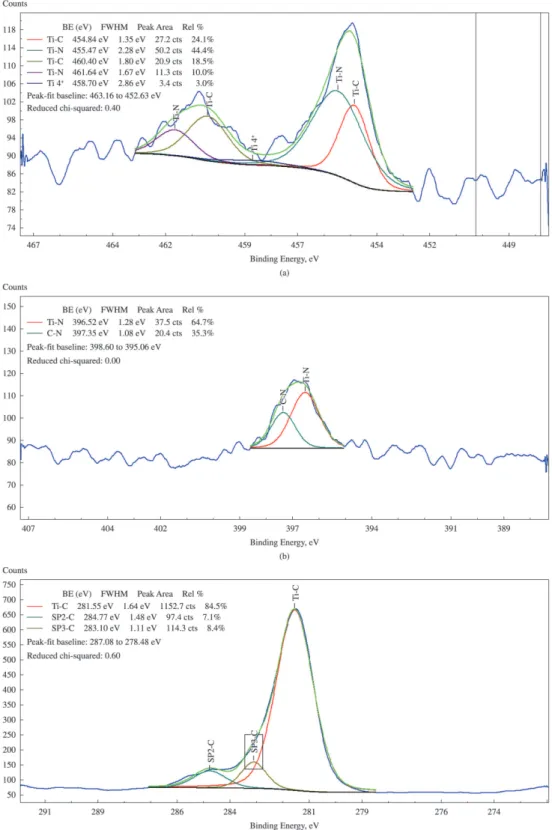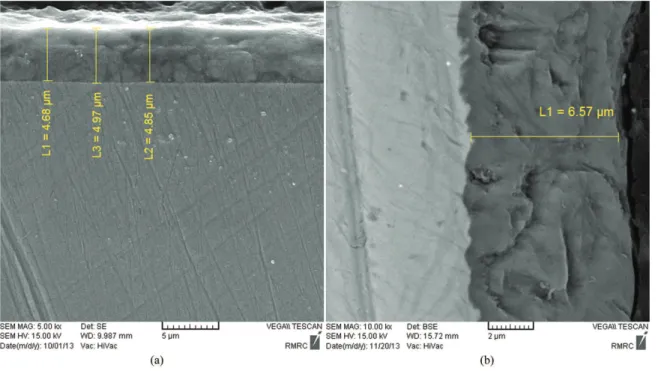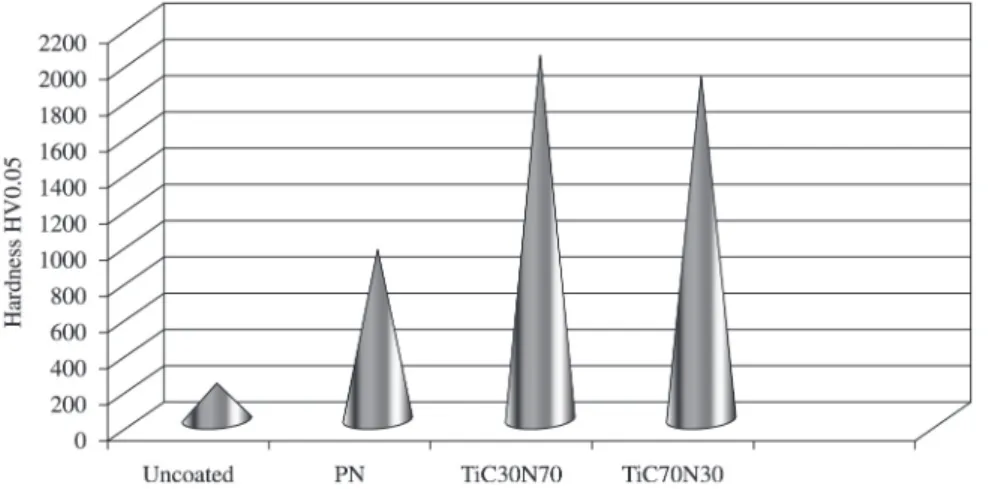*e-mail: shaiei@iust.ac.ir
1. Introduction
DIN 1.2606 (X4Cr5MoWSiV) steel is currently one of frequently used chromium-molybdenum tool steels, which contains high molybdenum content. This steel has various applications, such as hot forging dies, slotting tools, scissors, hot forging punches, etc. The mechanical, friction and wear properties of it have been extensively investigated as a function of tempering treatment and associated microstructure1,2.
The PACVD technique is an appropriate method to deposit wear and corrosion resistant hard coatings which have excellent properties applicable for several applications. In comparison to PVD methods, it offers the possibility of homogeneous coating on work pieces with complicated shapes. Other advantages of PACVD method are high adhesion and good morphology of the layers. Tools deposited with hard coatings, like TiN, TiCN, TiC, have already been used successfully for many industrial application3-6. The PACVD process is affected by several
process parameters, like discharge voltage, current density, gas pressure, gas composition and low rate7-9.
In the present research, the influence of the CH4/
(CH4+N2) gas low ratio on characteristics of PACVD TiCN
thin ilm on the hot – work tool steel has been investigated.
2. Experimental Procedure
TiCN coatings with compositional gradients were deposited on a X4Cr5MoWSiV hot-work tool steel substrate
using a PACVD coating system equipped with a voltage-controlled pulse generator.
During coating, process parameters such as gas low ratio, wall temperature, voltage duration of pulse-on and pulse-off time and total pressure were monitored. H2, Ar,
N2 and CH4 gases and TiCl4 vapor were used as process
gases for coating deposition. Total pressure was kept at 2 mbar and substrate temperature was controlled at 470°C to avoid exceeding the tempering temperature of the hot-work tool steel. Plasma nitriding was used as a pre-treatment to decrease hardness gradient between substrate and coating.
The processing parameters for the plasma nitriding are listed in Table 1. The N2/CH4 gas low ratio was deined
CH4/ (CH4+N2). The crystalline structure of the coatings was
determined by grazing incidence X-ray diffraction (GIXRD) in the continuous scanning mode using CuKα radiation (λ = 0.154056 nm). The full-width at half-maximum (FWHM) of the Bragg peaks is used to estimate the grain size based on Scherrer formula (Equation 1)10:
0.9 .
D= λβCOSθ (1)
Where D is grain size, β is the FWHM of the Bragg peak, and θ is the Bragg relection angle. The chemical composition of the ilm was analyzed by x-ray photoelectron spectroscopy (XPS) with monochromated AlKα radiation at the pass energy of 1486.6 eV. The ilm morphology was studied by scanning electron microscopy (SEM, VEGA-TESCAN-XMU) and atomic force microscopy (AFM,
Characterization of TiCN Thin Films Deposited by Dc-Pulsed
PACVD Using Methane Precursor
Seyed Mohammad Mahdi Shaieia*, Mehdi Divandaria,
Seyed Mohammad Ali Boutorabia,b, Rahim Naghizadeha
aSchool of Metallurgical Engineering, Iran University of Science and Technology,
Narmak, 1684613114, Tehran, Iran
bCenter of Excellence for High Strength Alloys Technology – CEHSAT,
University of Science and Technology, Narmak, Tehran, Iran
Received: July 15, 2014; Revised: November 12, 2014
Titanium carbonitride (TiCN) thin ilms were deposited on hot-work steel (DIN 1.2606) by plasma-assisted chemical vapor deposition (PACVD) and the inluence of different CH4/ (CH4+N2) gas low
ratio, on the layer mechanical properties, were investigated. SEM studies indicated that the growth rate is decreased by increasing the CH4/ (CH4+N2) gas low ratio. It was found that the Ti(C, N) layers
have different stoichiometry, TiC30N70 and TiC70N30 for 0.5 and 0.66 gas low ratio. Grazing incidence
x-ray diffraction (GIXRD), X-ray Photoelectron spectroscopy (XPS), scanning electron microscopy (SEM) and atomic force microscopy (AFM) were used to evaluate the microstructures as well as the morphological property such as roughness. It was also revealed that by increasing the low ratio, the grain size of the TiCN thin ilms is increased. A hardness of 2180 HV0.05 was obtained when the layer
was fabricated at the lower low ratios.
DME-DS-95-50E). The Vickers hardness of the TiCN coatings was measured using a micro-hardness test, within the loading range of 50 g; ive micro-hardness tests were performed for each sample to obtain the average values of the hardness.
3. Results and Discussions
Figure 1 illustrates the GIXRD patterns of the coatings deposited at 470 °C using the two gas mixtures. The (200) plane is revealed to be the preferred structure, deposited via kinetics-limited crystal growth11 and under
thermodynamically stable conditions because the (200) plane has the lowest energy surface in the TiCN crystal. This implies that the ilm structure is dense because the plane (200) orientation is the densely packed plane. The GIXRD pattern also indicates an exclusively face-center-cubic (FCC) structure which is closely related to Ti. Nitrogen and Carbon can be incorporated on the octahedral sites of both the hexagonal close-packed lattice of titanium and the FCC sublattice in TiCN and thus form TiCxNy. In stoichiometric
TiCN, it is assumed that all the octahedral sites are illed with nitrogen and carbon12.
Figure 1. GIXRD patterns acquired from the TiCxNy coatings using the two gas mixtures CH4/ (CH4+N2). a)0.66 and b)0.5. Table 1. PACVD parameters.
Parameters Value
Pulsed voltage 650 V
Duty cycle 33%
Temperature 470°C
PACVD time 120 min
CH4/ (CH4+N2) low ratio 50%, 66%
Total pressure 2 mbar
nitriding time 120 min
Titanium carbonitride is a compound stoichiometry of which in TiCxNy can vary in the range of 0<x, y<1.
Moreover, the peaks of the TiCN phase shift to lower angles13 and are close to the TiC phase while the C relative
contents reach around 45 at% measured by XPS. This is
ascribed to the substitution of N atoms with the bigger C atoms in the solid solution.
Figure 1 also indicates that by increasing the low ratio from 50% to 66%, the (220) plane is thermodynamically stable relative to the (200) plane and the broad peak of
the (200) plane in Figure 1b indicates that the grain size increases by increasing the low ratio. Hence, the speciic surface of TiCN decreases.
Only for a CH4/ (CH4+N2) gas low ratio of 0.5, the
colour of the TiCN layers is brown. At higher gas low ratio
it becomes increasingly dark blue. This is in conformation to the investigation reported by E. Erturk et al.14.
The later layers mentioned are not stoichiometric. When the gas low ratio was %50, the C/N ratio was 0.43 with TiC30N70 stoichiometric composition (Figure 1a). By
increasing the gas low ratio to %66, the C/N ratio changed to 2.33 and TiC70N30 stoichiometric composition (Figure 1b).
The TiC30N70 possesses a face-centered cubic (FCC) lattice
with ao=0.4258 nm and grain size 28.6 nm but the TiC70N30
possesses a face-centered cubic (FCC) lattice with ao=0.4287
nm and grain size 44.37 nm, so lattice parameter decreased with increasing gas low ratio. This is in conformation to the relation (Equation 2) proposed by Li Yuanbing et al for TiCxN1-x
[15].
0.4235 0.007 ( )
a= + x nm (2)
The residual stresses of the samples were determined by X-ray measurements. The surface residual stresses of TiCN layers were –28.74 MPa for %66 and –23.42 MPa for %50. The residual stress values increase with increasing the low ratio.
The crystallite percents were determined by X-ray diffraction. The crystallite percents of TiCN layers were %76 for % 66 gas low ratio and %85 for % 50. Also ilms deposited at low CH4/N2 ratios were much more crystallite
than those deposited at high ratios.
Figure 2 presents the XPS spectra of Ti 2p, N 1s and C 1s of the TiCN ilm. In the Ti spectrum, two peaks of Ti 2p are found at 462.7 and 468.4 eV. The N 1s spectrum exhibits a weak peak at 394.6 eV, which corresponds to the N–Ti bonds. The weak electronegative of C element, involves in the TiCN ilm formation, would slightly increase the binding energies of Ti–N. Cheng et al.16 have reported
that the binding energy of the N 1s spectra of the TiCN ilms is lower than that of the TiN ilms. The C 1s spectrum consists of three peaks at binding energies of 281.5, 283.4 and 285.2 eV. The peak at 281.5 eV is assigned to the Ti–C bonds17. The peaks at 283.4 eV and 285.2 eV are assigned
to the sp2–C and sp3–C bonds, respectively18. The C 1s
binding energies of pure graphite (284.3 eV) and diamond (285.3 eV) measured under the same conditions are cited for comparison.
It is also conveyed from Figures 2 and 3 that the peak at 281.5 eV occupies a large fraction of the total C 1s spectrum compared to the other peaks, indicating that a large fraction of C atoms are bonded to Ti atoms, and a little amount of C atoms exist as amorphous carbon. That is in conformation to GIXRD pattern.
Figure 2a shows that chemical composition is TiC0.426N0.544O0.03 for 50% and TiC0.453N0.51O0.038 for 66%
(Figure 3). Therefore the XPS spectra offer similar chemical composition for both cases while they were different from GIXRD patterns because the XPS spectra are very sensitive to surface analysis.
SEM images show the thickness of layer plus the rate of growth, both of them decreased by increasing gas low from 6.57 μm to 4.83 μm. (Figure 4)
Figure 5 shows the AFM images of the TiCN layers. High CH4 gas lows led to a high surface roughness of
the TiCN layers, as can be seen in the Figure 5b. A dense TiCN layer is grown in 50% but not in 66%, where the TiCN layer has a relatively rough structure. According to Quirós et al.19, increasing roughness could be due to the
fact that the assisting ions lead to signiicant damage and preferential sputtering effects, mainly during the deposition of the TiCN ilm. The effects are rather signiicant, inducing rougher surfaces and disappearance of the previous texture. Figure 5 shows that ilms deposited at low CH4/N2 ratios
are much more homogeneous than those deposited at high ratios. Most of deposited particles size is around 55 nm at low CH4/N2 ratios while it is approximately 90 nm at low
CH4/N2 ratios.
The hardness values of TiCN coatings deposited at a temperature of 470 °C with various low ratios are illustrated in Figure 6. A hardness value of 2038 HV0.05 for the low
ratio of 50% to a hardness of 1896 HV0.05 for the low ratio
of 66%. It means that the hardness of the TiCN coatings decreased as the low ratio increased. The reduction of hardness can be attributed to two reasons. When the low
Figure 5. Morphology of TiCN thin ilms via the CH4/ (CH4+N2) gas low ratio, evaluated by AFM. a)50% b)66%.
Figure 6. hardness values of TiCN coatings in various low ratios.
ratio increases, the grain size of the TiCN coatings are increased (as shown in Figure 1), resulting a decrease in the hardness of TiCN coating. Furthermore, during the growth of the grain size, the chlorine atoms can diffuse into high angle grain boundaries, after exceeding the solubility limit of chlorine in the TiCN lattice20. Thus, the hardness of the
4. Conclusion
The following conclusions can be drawn from this research:
1- TiC30N70 stoichiometric composition was obtained in
0.5 gas low ratio and TiC70N30 for 0.66 which were
different from XPS results.
2- XPS peaks indicate that a large fraction of C atoms are bonded to Ti atoms, and a low fraction of C atoms exist as amorphous carbon.
3- The ilms grown, using plasma-assisted processes at lower low ratios were generally ine-grained and had a denser structure.
4- It was found that the growth rate decreased with increasing the low ratio.
5- Finally, it was found that the surface hardness decreased with increasing the flow ratio due to decrease in grain size and diffusion of chlorine in grain boundary.
References
1. Mebarki N, Delanges D, Lamesle P, Delmas F and Levaillant C. Relationship between microstructure and mechanical properties of a 5% Cr tempered martensitic tool steel. Materials Science and Engineering A. 2004; 387-389:171-175. http://dx.doi.
org/10.1016/j.msea.2004.02.073.
2. Barrau O, Boher C, Gras R and Rezai-Aria F. Analysis of the friction and wear behaviour of hot work tool steel for forging. Wear. 2003; 255(7-12):1444-1454. http://dx.doi.org/10.1016/
S0043-1648(03)00280-1.
3. Rie KT, Gebauer A, Wöhle J, Tönshoff HK and Blawit C. Synthesis of TiN/TiCN/TiC layer systems on steel and cermet substrates by PACVD. Surface and Coatings Technology.
1995; 74-75:375-381. http://dx.doi.org/10.1016/0257-8972(95)08243-3.
4. Hedenqvist P, Olsson M, Wallen P, Kassman A, Hogmark S and Jacobson S. How TiN coatings improve the performance of high speed steel cutting tools. Surface and Coatings Technology. 1990; 41(2):243-256.
http://dx.doi.org/10.1016/0257-8972(90)90172-9.
5. Sundgren JE. Structure and properties of TiN coatings. Thin Solid Films. 1985; 128(1-2):21-44. http://dx.doi. org/10.1016/0040-6090(85)90333-5.
6. Kenneth L, Steve S, Jun Q and Paul S. Foreword from the
Editors. Wear. 2009; 267(1-4):2142-2156. http://dx.doi. org/10.1016/j.wear.2009.04.001.
7. Rie KT, Gebauer A and Woehle J. Investigation of PA-CVD of TiN: Relations between process parameters, spectroscopic measurements and layer properties. Surface and Coatings Technology. 1993; 60(1-3):385-388. http://dx.doi. org/10.1016/0257-8972(93)90118-8.
8. Ishii Y, Ohtsu H, Adachi T, Ichimura H and Kobayashi K. TiN film formation by plasma chemical vapor deposition and its plasma diagnostics. Surface and Coatings Technology.
1991; 49(1-3):279-283. http://dx.doi.org/10.1016/0257-8972(91)90069-9.
9. Zhang H, Yan D and Tang S. Preparation and properties of ultra-fine TiCN matrix cermets by vacuum microwave sintering. Rare Metals. 2010; 29(5):528-532. http://dx.doi.org/10.1007/ s12598-010-0162-8.
10. Cullity BD. Elements of X-ray Diffraction. 2nd ed. Reading: Addison Wesley; 1978.
11. Niederhofer A, Bolom T, Nesladek P, Moto K, Eggs C, Patil DS, et al. The role of percolation threshold for the control
of the hardness and thermal stability of super- and ultrahard nanocomposites. Surface and Coatings Technology. 2001;
183:146-147.
12. Barker MG, Alexander IC and Bentham J. The reactions of liquid lithium with the dioxides of titanium, zirconium, hafnium and thorium. Journal of the Less Common Metals. 1975; 42(2):241-247.
http://dx.doi.org/10.1016/0022-5088(75)90010-7.
13. Klemberg-Sapieha JE, Jedrzejowski P and Martinu LJ. Mechanical and optical characteristics of superhard nanocomposite TiN/a-Si3N4 and TiCN/a-SiCN coatings produced by PECVD. Superhard Mater. 2007; 29(3):147-152. http://dx.doi.org/10.3103/S1063457607030069.
14. Ertürk E, Knotek O, Burgmer W, Prengel HG, Heuve HJ, Dederichs HG, et al. Ti(C,N) coatings using the arc process. Surface and Coatings Technology. 1991; 46(1):39-46. http://
dx.doi.org/10.1016/0257-8972(91)90148-P.
15. Yuanbing L, Nan L, Guozhi R, Jianwei L and Xiaohui L. Effects of technical factors on MgAl2O4–TiN composites produced by aluminothermic reduction and nitridation. Materials & Design. 2007; 28(3):969-972. http://dx.doi.org/10.1016/j.
matdes.2005.10.006.
16. Cheng YH, Browne T and Heckerman B. Influence of CH4 fraction on the composition, structure, and internal stress of the TiCN coatings deposited by LAFAD technique. Vacuum. 2010;
85(1):89-94. http://dx.doi.org/10.1016/j.vacuum.2010.04.007. 17. Meng J, Lu J, Wang J and Yang S. Tribological behavior
of TiCN-based cermets at elevated temperatures. Materials Science and Engineering A. 2006; 418(1-2):68-76. http://
dx.doi.org/10.1016/j.msea.2005.11.022.
18. Jiang JL, Hao JY, Pang XJ, Wang P and Liu WM. Structure and characteristics of amorphous (Ti,Si)–C:H films deposited by reactive magnetron sputtering. Diamond and Related Materials. 2010; 19(10):1172-1177. http://dx.doi.org/10.1016/j.
diamond.2010.05.005.
19. Quirós C, Prieto P, Fernández A, Elizalde E, Morant C, Schlögl R, et al. Bonding and morphology study of carbon nitride films obtained by dual ion beam sputtering. Journal of Vacuum Science & Technology. A, Vacuum, Surfaces, and Films. 2000;
18(2):515. http://dx.doi.org/10.1116/1.582218.
20. Stoiber M, Badisch E, Lugmair C and Mitterer C. Low-friction TiN coatings deposited by PACVD. Surface and Coatings Technology. 2003; 163-164:451-456. http://dx.doi.org/10.1016/




